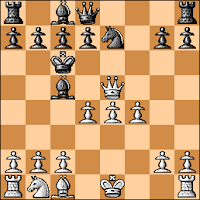 A big hope of someone who plays the Jerome Gambit (1.e4 e5 2.Nf3 Nc6 3.Bc4 Bc5 4.Bxf7+) is that the sacrifice of a piece at f7 will put the enemy King in sufficient danger that a successful attack can follow.
A big hope of someone who plays the Jerome Gambit (1.e4 e5 2.Nf3 Nc6 3.Bc4 Bc5 4.Bxf7+) is that the sacrifice of a piece at f7 will put the enemy King in sufficient danger that a successful attack can follow.Sometimes, it actually does.
perrypawnpusher - vypux
blitz 5 7, FICS, 2009
1.e4 e5 2.Nf3 Nc6 3.Bc4 Bc5 4.Bxf7+ Kxf7
 Jerome Gambit 101.
Jerome Gambit 101.5.Nxe5+ Nxe5 6.Qh5+ Ke6
 7.Qf5+ Kd6 8.f4 Ne7
7.Qf5+ Kd6 8.f4 Ne7  Last seen in my game against TheChessInnovator (see "The Black Knight"), this is one of many ways for Black to return a piece.
Last seen in my game against TheChessInnovator (see "The Black Knight"), this is one of many ways for Black to return a piece.Better for Black here appears to be the more mainline 8...Qf6 or 8...Qh4+
9.Qxe5+ Kc6 10.d4
 Again missing, as I did against TheChessInnovator, the superior 10.Qc3 (with the threat of b4, winning the Bishop) which would have given me an advantage.
Again missing, as I did against TheChessInnovator, the superior 10.Qc3 (with the threat of b4, winning the Bishop) which would have given me an advantage.10...d6 11.d5+
 This is the move that I had relied upon, hoping to chase the enemy monarch to the Queenside. The plan worked, but Rybka's suggestion of 11.Qxg7 (leading to an edge for the second player) shows that my chances had been reduced by my 10th move to pawn-grubbing.
This is the move that I had relied upon, hoping to chase the enemy monarch to the Queenside. The plan worked, but Rybka's suggestion of 11.Qxg7 (leading to an edge for the second player) shows that my chances had been reduced by my 10th move to pawn-grubbing.11...Kb5
Too cooperative. Instead, Rybka's 11...Kd7 12.Qxg7 Qe8 13.Rf1 Rg8 14.Qxh7 Kd8 looks about even, if messy.
12.a4+ Kb6
Again, probably not best. If the Black King goes to a6 instead, it will be more difficult to get at him. Of course, I'd still prefer to be White. As the song goes, I'd rather be a hammer than a nail...
Now, any player with attacking pretensions has to be thinking: there's got to be something to find here.
13.a5+ Kb5
 Black's King looks terribly unsafe -- and it is.
Black's King looks terribly unsafe -- and it is. 14.Qc3 Bb4 15.Na3+ Kxa5

Leading to mate, but surrendering the piece with 15...Ka6 16.Qxb4 led to a grim and ultimately losing position as well.
16.Nc4+ Kb5 17.Ra5+ Bxa5 18.Qxa5+ Kxc4 19.b3+ Kd4 20.Qb4 checkmate

2 comments:
Hi Rick, it was nice to find your blog. It reminded me of the Sicilian Jerome Gambit I used to play. (I just invented the name :-)
Welcome, Jyrki!
The Sicilian Jerome Gambit ! THAT will get a lot of players thinking!
Thanks for sharing.
Jyrki Heikkinen is the host of the blog Gambits and Pieces at http://gambits.blogspot.com and the foremost theoretician and practitioner of the Diemer Duhm Gambit 1.d4 d5 2.c4 e6 3.e4 at http://www.nic.funet.fi/pub/doc/games/chess/ddg/. He also plays a mean Blackmar Diemer Gambit 1.d4 d5 2.e4 dxe4 3.Nc3
I'm glad you stopped by.
Rick
Post a Comment